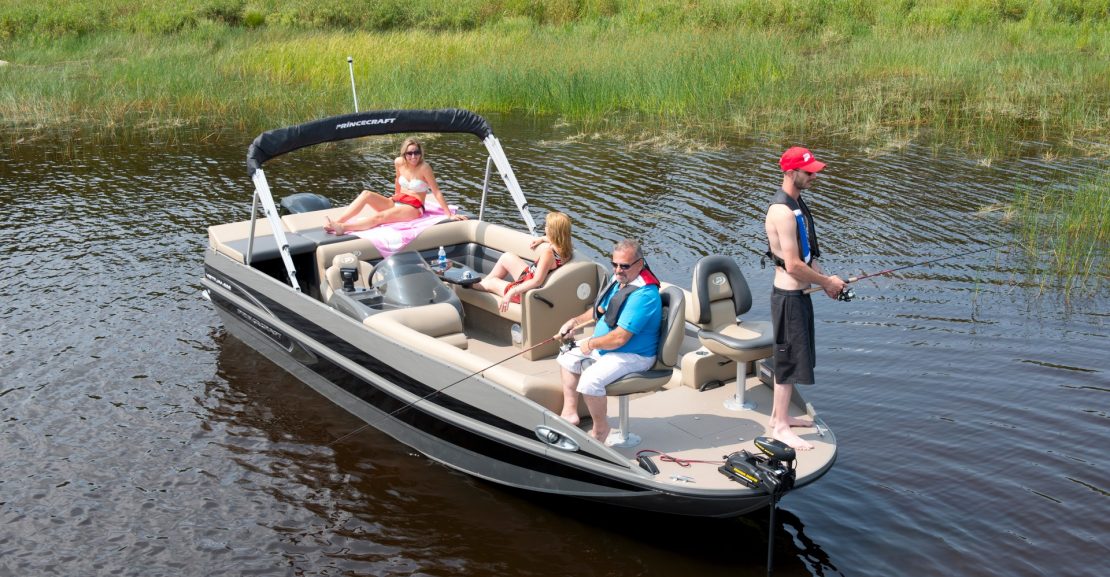Princecraft has updated its Ventura 222 deck boat for the 2015 season. Like many boating enthusiasts, you have probably asked yourself what a deck boat is and why there are so few on the water.
To give you some background, deck boats are fairly similar to bowriders. Most of them are designed with a fibreglass hull and an entirely open bow to hold more passengers. However, like a pontoon boat, the beam (width) of a deck boat is carried further forward, which makes them even more spacious and gives them a distinctive look and performance style. In short, this type of boat focuses more on practical advantages rather than on style or the joy of driving.
100% aluminium
Princecraft groups its deck boats under its Ventura line, which offers six boats in sizes that vary between 19 and 22 feet. What sets them apart from their competitors is that their hulls are made entirely from aluminium, making them much lighter and easier to maintain. Princecraft is counting on its most celebrated feature: aluminium.
We tested the Ventura 222, which is 22′ 2″ long (6.8 m) with a beam of slightly more than 8.2′ (2.5 m). Weighing in at 2,250 lbs. (1,021 kg), it is about 50% lighter than its competitors with fibreglass hulls. This gives it an advantage in terms of fuel consumption and ease of towing.
From the outside, the fully painted hull makes it look like a conventional boat. It is hard to believe that the Ventura 222 is aluminium, a feature that works in its favour. While this year’s new colours enhance its overall look, the design is much boxier than a bowrider’s. At the end of the day, you have to like this type of boat.
On deck, the floor is flat and, like a platform, stretches up to the bow. The manufacturer offers several types of interior layouts, depending on the version. Our Ventura was halfway between a fishing boat and a pontoon boat. To the stern, there is a raised sunpad with a folding section that allows you to reach the aft deck. An L-shaped bench completes the central layout, while the captain has a helm console and a captain’s chair. Unlike a bowrider, the boat doesn’t have a windshield.
Farther forward, there are two soft padded benches on either side of the boat, creating a practical, highly comfortable space. In the bow, two fishing chairs have been placed on a raised platform, adding to the boat’s practicality. The layout is undoubtedly versatile, but the mix of styles results in a strange environment.
Pleasing performance
The Ventura 222 is offered at a base price of $41,470 and may be equipped with an outboard engine whose power can vary between 115 and 200 hp. Our test model had a 175-hp Mercury Verado engine, which provided excellent performance due to its high power-to-weight ratio. By the way, the engine is remarkably silent, making it more of a pleasure to drive. One of the additional advantages of outboard motors is that 100% of onboard space can be used, as none is sacrificed for the engine.
Princecraft uses three different processes (welding, riveting and gluing) to ensure its boats are sturdy. Because of this, you don’t feel like you’re on an aluminium vessel. It feels solidly built.
With their flatter hulls, deck boats have different dynamics. First, while the bow of a conventional boat rises when it speeds up, deck boats remain much straighter, which improves visibility. The same thing happens during turns, when the boat barely leans and seems to glide a bit more on the water. However, on waves and choppy bodies of water, the pronounced V of other types of boats provides an advantage as it helps the boat cut through the waves more cleanly. This is why deck boats are better for smaller bodies of water.

